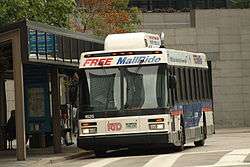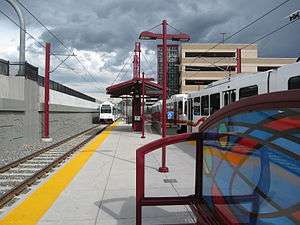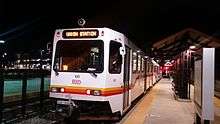Regional Transportation District
 | |
| Overview | |
|---|---|
| Locale | Denver Metro Area, Colorado |
| Transit type | Bus, light rail, and commuter rail |
| Number of lines | 138 |
| Daily ridership | 339,300 weekday boardings (2015)[1] |
| Chief executive | Dave Genova[2] |
| Headquarters |
1600 Blake Street Denver, CO 80202 |
| Website |
rtd-denver |
| Operation | |
| Began operation | 1972 |
| Operator(s) | Regional Transportation District |
The Regional Transportation District, more commonly referred to as RTD, was organized in 1969 as the regional authority operating public transit services in eight out of the twelve counties in the Denver-Aurora-Boulder Combined Statistical Area in Colorado. It operates over a 2,340-square-mile (6,100 km2) area, serving 2.87 million people. RTD is governed by a 15-member, publicly elected Board of Directors. Directors are elected to a four-year term and represent a specific district of about 180,000 constituents.[1]
RTD currently operates a bus and rail system that has a service area of 2,337 square miles (6,050 km2). It employed 2,734 people and reported 103 million boardings in 2016.[1] It had a $466.7 million operating budget for the year of 2015.[1] Google has RTD schedules attached to its trip planner, and 3rd party mobile applications are now available for the iPhone and other platforms.
RTD is constructing the voter-approved FasTracks transit expansion that will add 122 miles (196 km) of new commuter rail and light rail, 18 miles (29 km) of rapid transit bus service, 21,000 new parking spaces at rail and bus stations, and enhance bus service across the eight-county district.
Timeline

- Pre-RTD: The principal provider of public transportation was the Denver Tramway Company, which served the City and County of Denver as well as older portions of Arvada, Aurora, Englewood, Golden, Lakewood, Westminster, and Wheat Ridge and smaller suburbs.
- 1969: RTD was created in the 47th session of the Colorado General Assembly to provide public transportation to five additional counties in the metropolitan area.
- 1969–1971: The Denver Tramway Company continues service under sponsorship of the City and County of Denver.
- October 1970: RTD found it needed to establish a Northern Operations Group (NOG) to provide service to Boulder and Longmont. RTD also acquired the privately owned Denver-Boulder Bus Company, which ran airport buses.
- 1971: Denver Metro Transit took over the privately owned Denver Tramway Company. Denver Metro Transit was an entity created by the City and County of Denver. Suburban service only continued for those suburbs willing to contribute a subsidy.
- 1972: RTD created a plan for a personal rapid transit (PRT) system in the area, and a transportation plan was completed—three years after the 1969 legislative mandate. This plan included 98 miles (158 km) of PRT and extensive bus service throughout the areas served by RTD. Later that year, the Urban Mass Transportation Administration (UMTA) selected RTD to develop PRT as a demonstration project.
- 1973: Residents voted for a sales tax of 1/2% over the six counties served by RTD for ten years; 20% of the funds would be used for expanded bus service and the other 80% were earmarked for PRT construction. The PRT project was eventually scrapped.
- July 1974: Denver Metro Transit became part of RTD.
- 1975–1977: RTD consolidated, expanded, and improved service frequency. Service was expanded to routes that commercial carriers previously operated.
- February 1978: Inflation caused RTD to implement a new fare structure.
- September 5, 1978: RTD completely replaced all bus routes, formerly mostly radials from downtown Denver following old streetcar routes, with new routes based on a grid system, numbered based on the hundred blocks of the street grid. For instances, the new Colorado Blvd (4000 east block) route was number 40, and the new 10th Avenue (1000 north block) route was number 10.

- 1979: Federal approval was granted for the 16th Street Mall in downtown Denver, originally known as Transitway. The project allowed express bus productivity to double and was eventually intersected by RTD's first light rail line, the D Line, at Stout and California streets.
- 1980: RTD reached a record number of weekday passengers, and expanded the park-'n'-Ride system. It also acquired 216 new buses, 89 of which were articulated. Construction began on the 16th Street Mall. Work was also completed to make RTD's service more accessible to elderly and handicapped people.
- September 1994: Downtown Express/High Occupancy Vehicle (HOV) lanes were opened to buses, and to carpools a year later.
- October 1994: RTD opened the Central Corridor light rail line, bringing rail transit back to the region.
- 2000: The Southwest Corridor light rail line opened.
- 2002: The Central Platte Valley spur of RTD's light rail service opened.
- 2003: The downtown portion of the original line between Speer Boulevard and 14th Street was realigned as a result of construction of the Colorado Convention Center.
- April 2006: Unionized transit workers of the Amalgamated Transit Union went on strike for the first time in 24 years, citing increased health care costs, mandatory overtime, and disproportionate wage increases relative to upper management. Workers walked off the morning of April 3, shutting down the light rail system and decreasing bus service to about 45% of its normal capacity, the remaining service being provided by existing RTD subcontractors Laidlaw, Connex, and First Transit. Laidlaw and Connex, whose workers are contracted rather than unionized, would take over many routes operated by RTD, albeit on a reduced schedule, while First Transit, whose workers are unionized, operated only its own routes due to its contract with its workers. A revised contract was approved by the union on April 7, and service resumed on April 10. The strike lasted a total of seven days, and although thousands of commuters were stranded by the strike, only a few backups were reported as customers made makeshift arrangements for commuting or waited out the strike.[3]
- November 17, 2006: The Southeast Corridor, a component of the Transportation Expansion Project, opened.
- April 26, 2013: The West Rail Line of the light rail opened.
- May 11 and 12, 2014: RTD's Market Street Station closed and was replaced by the newer Union Station.[4] The Free MetroRide service began along 18th and 19th streets between Union Station and Civic Center Station.[5]
- April 22, 2016: University of Colorado A Line is the first commuter rail line to open.
- July 25, 2016: The second commuter rail line, the first 6.2 mile segment of the B Line, officially opens.
Fleet
Gillig and Orion buses make up most of the fleet. In 2014, RTD began to receive New Flyer low floor buses for the free MetroRide and other routes.[6] MCI and Neoplan vehicles are used as express buses and regional buses. Siemens SD100 and SD160 are used as light rail vehicles. As of May 2015, the RTD light rail fleet had 172 light rail vehicles, serving 48 miles (77 km) of track and 46 stations.[1] For RTD's new commuter rail system, Silverliner V's will be used.
Fares
The current RTD fare structure is based on a zone system for rail and a service level system for bus. Local/Limited bus routes or a 1–2 zone trip on rail costs $2.60, Regional routes or traveling 3 zones on rail costs $4.50, and travel on bus or rail to Denver International Airport costs $9.[7] Seniors, students, people with disabilities, and Medicare recipients are eligible for reduced fares. No fare to kids below 6 with fare-paying rider; limit is 3. RTD also offers a local Day Pass ($5.20) and a Regional/Airport Day Pass ($9) which allows unlimited travel at the chosen fare level for the entire day.
The current fare system was introduced in January 2016 in preparation for the completion of 4 FasTracks rail lines in 2016. The new simplified fare structure included the removal of the Express fare level, pared down the rail fare zones from 4 to 3, and consolidated the tiered SkyRide fares into a single Airport Fare. A new day pass option was also introduced, allowing riders to take multiple trips at twice the cost of a one-way ticket.[8] However, the base fare one-way fare was increased by 15% to $2.60, attracting criticism for disproportionately affecting low-income residents.[9]
A fare card program is being implemented, and will include the MyRide Stored Value card as well and the unlimited EcoPass and CollegePass cards. The card, in development for over four years by Xerox, is currently only available through employers as the EcoPass and colleges as the CollegePass, and through a limited public pilot program of the stored value MyRide card.[10][8] Users of the MyRide card receive a discount on fares compared to normal prices.
Projects
Past projects
Downtown Express

This project added HOV lanes to I-25 north of downtown Denver. It also added several dedicated slip ramps for RTD buses to access several Park-n-Ride stations directly from the highway. At the south end of the HOV lanes, buses had direct routes into Union Station or Market Street Station. The HOV lanes extended from I-25 to US 36, allowing regional and express routes running along US 36 to downtown Denver to bypass congestion around the Turnpike Tangle. This project was completed in September 1994.
In 2006, the Downtown Express was renovated to include a toll lane, thereby converting the HOV lanes into high-occupancy toll lanes. This allows single-occupancy vehicles to pay a toll to use them. It was built to increase the overall usage and efficiency of the highway's HOV lanes. The project was completed on June 2, 2006.

Central Corridor
The Central Corridor, a 5.3-mile (8.5 km) light rail line, opened in October 1994. It was built along Welton Street, through the Five Points district along Stout Street and California Street, and following a railroad right-of-way from Colfax Avenue down to the intersection of I-25 and Broadway. This line was built without the aid of tax increases or federal funds; however, extensions have been funded by the Federal Transit Administration and new tax measures. This line was built from 30th/Downing as the northern terminus to I-25/Broadway as the southern terminus.
Southwest Corridor
After the success of the Central Corridor, the Southwest Corridor light rail route opened in July 2000. An 8.7-mile (14.0 km) light rail line, the route runs from the terminus of the Central Corridor at I-25 & Broadway to Mineral Avenue in Littleton with five existing stations. The line has been popular, and the park-n-Ride lots at its stations often experience parking shortages. This project built a light rail line from I-25/Broadway south to Littleton/Mineral alongside existing freight tracks used by BNSF next to Santa Fe Drive.
Central Platte Valley Corridor

In April 2002, the Central Platte Valley (CPV) spur opened. It is a 1.8-mile (2.9 km) branch with four stations that provides light rail access to numerous venues, including the Auraria Campus, Sports Authority Field at Mile High, Pepsi Center, Elitch Gardens, Union Station and Coors Field. This project built light rail lines from 10th/Osage to Union Station.

T-REX Project

In November 1999, Denver area voters approved a project, known as the T-REX, which involved reconstruction of I-25 between Broadway and Lincoln Avenue in Lone Tree, and I-225 between I-25 and Parker Road in Aurora, with widening of the road to five lanes and light rail being built. The highway project was completed on August 22, 2006. The light rail line, known as the Southeast Corridor, opened shortly after 11 a.m. on November 17, 2006. The line covers 19.1 miles (30.7 km) and includes thirteen new stations, with parking available at all but the Louisiana/Pearl station.
West Rail Line

The West Rail Line opened on April 26, 2013. It was the first completed rail line of the RTD FasTracks Project. The 12.1 miles (19.5 km) of light rail run between Denver Union Station and Jefferson County Government/Golden Station, adding 11 new stations, 6 park-n-rides, and 3 new call-n-rides.[11]
Projects under development
FasTracks is a major project to dramatically expand the metro areas rail service. The less densely populated north metro area will receive two commuter rail lines, while the west metro will receive a light rail line and a commuter rail line. In addition, a commuter rail line will connect Denver International Airport to downtown. Union Station is being redeveloped into the hub of the rail network, with a large mixed-use transit-oriented development being built on the surrounding properties, many of which previously sat vacant for years. In addition to renovations to the historic station, the majority of the surrounding property is also being developed into apartment and office buildings, nearly all of which will also feature retail space.
RTD completed the Union Station bus pavilion, the launch of the free MetroRide, and the closure of Market Street Station on May 11, 2014. A redeveloped Union Station building also officially opened to the public on July 26, 2014, and is now home to several restaurants/bars/cafes, retail shops and the boutique Crawford Hotel. The historic building sits directly adjacent to the southeast end of RTD's underground bus concourse and the above-ground Train Hall. The Train Hall is currently home to the twice-daily Amtrak service, and will eventually also serve as the terminal to RTD's commuter rail lines when they come online. The building was developed to complement the transit portions of Union Station as a transportation hub by providing a commercial center to cater to transiting passengers as well as residents, workers and visitors in Downtown Denver.
Bus rapid transit on US 36, the first segment of the Northwest Rail Line, the East Rail Line, the Gold Line, and the I-225 Rail Line are all scheduled to open in 2016, while the first segment of the North Metro Rail Line is scheduled to open in 2018. The FasTracks project is scheduled to be completed in 2044.[12]
References
- 1 2 3 4 5 "Facts & Figures". RTD. Retrieved 17 August 2016.
- ↑ "Interim General Manager". RTD. Retrieved 30 May 2015.
- ↑ Shore, Sandy (April 3, 2006). "Transit strike begins". The Denver Post. The Associated Press. Retrieved 30 May 2015.
- ↑ "Market Street Station Closed". RTD.
- ↑ "Denver's Union Station now open with free MetroRide service to Civic Center Station". 7NEWS.
- ↑ "New Flyer wins 5-year Denver RTD contract". metro-magazine.com.
- ↑ "Fares". Regional Transportation District. Retrieved 27 February 2016.
- 1 2 Whaley, Monte (May 26, 2015). "RTD riders to see new fares, critics say poor will be stung the most". The Denver Post. Retrieved 27 May 2015.
- ↑ Whaley, Monte (February 18, 2015). "Poor, homeless in Denver metro area sound off on RTD fares". The Denver Post. Retrieved 27 May 2015.
- ↑ "MyRide". Regional Transportation District. Retrieved 27 February 2016.
- ↑ "West Rail Line Home". rtd-fastracks.com.
- ↑ Program Schedule: http://www.rtd-fastracks.com/main_31
- ^ Timeline between 1969 and 1982 provided from "RTD A History: 1969-82" published 1983 by the Regional Transportation District.
External links
| Wikimedia Commons has media related to Regional Transportation District. |
- Official Website
- The Transit Alliance – A non-profit coalition promoting expanded rail and bus transit in the Denver Metro region.
